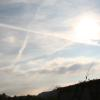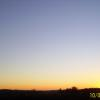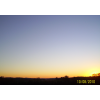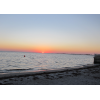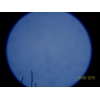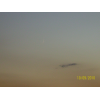نتائج رصد هلال ذو القعدة لعام 1431 هـ
- توقع رؤية هلال أول الشهر (ذو القعدة)
- نتائج تحري هلال أول الشهر (ذو القعدة)
- بداية الشهر الرسمية
- توقع رؤية هلال آخر الشهر (شوال)
- نتائج تحري هلال آخر الشهر (شوال)
توقع رؤية هلال أول الشهر (ذو القعدة)
سيحدث الاقتران المركزي (المحاق المركزي) يوم الخميس 7 تشرين أول/ أكتوبر 2010 في الساعة 18:44 بالتوقيت العالمي بمشيئة الله
إمكانية رؤية الهلال يوم الخميس 7 تشرين أول/ أكتوبر 2010 و يوم الجمعة 8 تشرين أول/ أكتوبر 2010 موضحة في الأشكال التالية باستخدام برنامج المواقيت الدقيقة باعتماد معيار عودة، بحيث:-
- رؤية الهلال مستحيلة من المناطق الواقعة في اللون الأحمر بسبب غروب القمر قبل غروب الشمس أو/و بسبب حصول الاقتران السطحي بعد غروب الشمس.
- رؤية الهلال ممكنة باستخدام التلسكوب فقط من المناطق الواقعة في اللون الأزرق.
- رؤية الهلال ممكنة باستخدام التلسكوب من المناطق الواقعة في اللون الزهري، ومن الممكن رؤية الهلال بالعين المجردة في حالة صفاء الغلاف الجوي التام والرصد من قبل راصد متمرس.
- رؤية الهلال ممكنة بالعين المجردة من المناطق الواقعة في اللون الأخضر.
- رؤية الهلال غير ممكنة بالعين المجردة أو بالتلسكوب من المناطق غير الملونة، على الرغم من غروب القمر بعد غروب الشمس ومن حصول الاقتران السطحي قبل غروب الشمس، وذلك بسبب قلة إضاءة الهلال و/أو بسبب قربه من الأفق.
- يرجى ملاحظة أن الأشكال أدناه تبين إمكانية رؤية الهلال في المناطق الواقعة بين خطي عرض 60 شمالا و60 جنوبا.
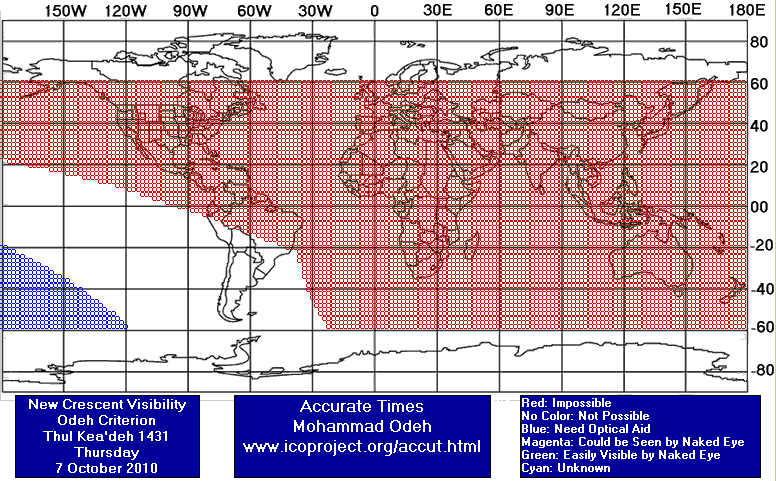
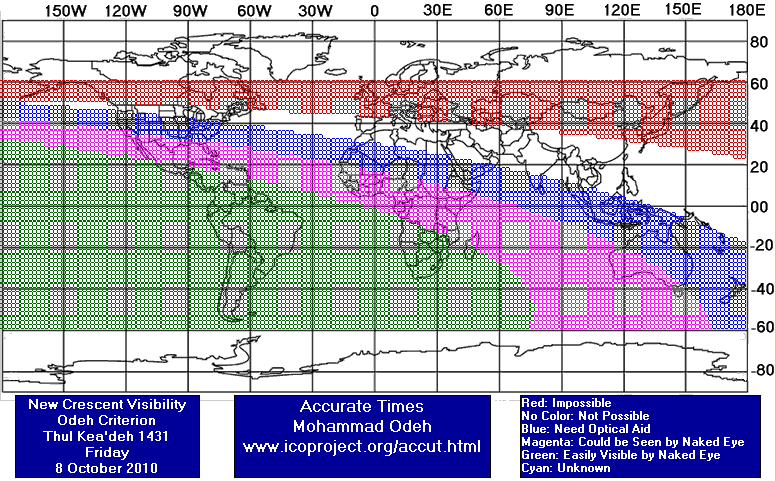
باعتماد التقويم الهجري العالمي المبني على حساب إمكانية رؤية الهلال، فإن بداية الشهر في النطاق الشرقي تكون يوم السبت 9 تشرين أول/ أكتوبر 2010 ، وبداية الشهر في النطاق الغربي تكون يوم السبت 9 تشرين أول/ أكتوبر 2010. الرجاء ملاحظة أن التقويم الهجري العالمي يعتمد على الحسابات المسبقة ( اي لا ينتظر الرصد العملي و رؤية الهلال ) و هو يتبنى معياراً معينا لبدء الشهر الهجري الجديد .و قد تتبنى بلدك او منظمتك معياراً آخر لبدء الشهر لذا فإننا ننصح و بشدة أن يتم الاطلاع عما جاء في صفحة التقويم الهجري العالمي في موقعنا قبل إصدار اي أحكام .
ستضاف نتائج تحري الهلال وبداية الشهر الرسمية في مختلف الدول الإسلامية في هذه الصفحة إن شاء الله فور استلام نتائج الرصد من قبل أعضاء المشروع الإسلامي لرصد الأهلة.
نتائج تحري هلال أول الشهر (ذو القعدة)
الجمعة 08 أكتوبر 2010
ألمانيا
وقال عضو المشروع المهندس مارتن إليسياسر "The autumn fog only lifted two hours after noon and the skies remained hazy with cirrus clouds in several layers. I could capture the crescent with the established contrast enhancement technique and follow it for several hours till it dropped behind the trees, some 4° above the horizon. The bad sky conditions prevented capturing more detailed images. The last observation happened about 40 minutes before moonset, with the moon setting some 8 minutes before the sun. "
المملكة العربية السعودية
وقال عضو المشروع السيد صالح الصعب "The crescent was only (1.5) degrees above the horizon at sunset only."
المملكة المتحدة
وقال عضو المشروع المهندس قمر الدين "On Friday 8 October 2010 (29 Shawwal 1431 AH) many people from UK including York have attempted to sight the crescent moon (Hilal) of Dhul Qaidah after sunset. Most places were cloudy so none of the groups were able to sight the Hilal. However, we have received reliable sighting news (Muhaqaq Ruyat-e-Basari) from South Africa. Therefore, the Ulama in UK have decided that the month of Shawwal 1431 AH will have 29 days and the month of Dhul Qaidah 1431 AH will start from Saturday 9 October 2010, Insha-Allah."
النرويج
وقال عضو المشروع السيد ميلاد إرشاقي "On Friday, October 8, 2010, sunset time in Oslo, Norway was 6:30pm and moonset time was 5:52pm. So it was not astronomically possible to see the moon. I tried to look for it anyhow after sunset - but did not see the moon."
الولايات المتحدة
وقال عضو المشروع الدكتور جواد تورابنيجاد "My wife, daughter, and I using a pair of binoculars (7X50) were able to sight a very thin crescent in Blacksburg, VA. The first binocular sighting was at 1:55 pm (sunset 6:54 pm EDT; moonset 7:11 pm). My last sighting was at 4:25 pm. To find the moon's location, I used the Sky & Telescope Interactive Sky Chart. Venus which was first observed at 1:06 pm helped me in locating the moon. The crescent was about 12 degrees to the lower left of the sun (the sun was blocked by our house). The horns were at about 12:30 and 3:00 O'clock (12:30;2:00;3:00). I was unable to sight the crescent with naked eye, however. The sky was clear. This evening, I also tried sighting the moon in Blacksburg, with no success. Soon after arriving at my sighting location, I searched for Venus which was observed first by a pair of binoculars (7X50) followed by naked eye sighting at 6:36 pm (sunset 6:54 pm EDT). Then, I started scanning the west southwest horizon for the moon. I continued this till past moonset (moonset 7:11 pm). The horizon was clear with some haze."
وقال عضو المشروع الدكتور حسين دشتي "Salam Alaikom, Today, Friday the 8th of October 2010, I went to sight the Hilal in Clearwater, Florida. I was able to sight it with my 10X50 binocular only. The crescent's calculations were: - Sunset: 19:08 LT T. Moon Age: +28H 10M - Moonset: 19:37 LT Moon Lag Time: +00H 29M T. Moon Altitude: +04°:57':38" T. Elongation: +16°:40':21" T. Relative Azimuth: -15°:38':57" T. Crescent Width: +00°:00':42" T. Illumination: 02.11 % The actual sunset was at 19:08. The hilal was first sighted by binocular at 19:17, and was last sighted by binocular at 19:31. This is the first time for me to sight a Hilal with a lag time of 29 minutes. The clear sky is shown in the attached photo. Thanks Dr. Hussain Dashti Clearwater, Florida"
وقال عضو المشروع الدكتور جون كالدويل "excellent conditions, seen from 1941, clearly seen from 1945, blocked by distant peak from 1950, only "glimpsed" not "seen" for about 2 minutes before 1941, seeing before 1945 needed binocular pointing as location aid, venus confirmed pointing system, easily seen in binoculars on first try (1933) so no doubt could have found it earlier in binoculars had I tried; visually 1941-1944: seeing at limit of "real seeing", 1945-1949: clearly seeing but never "easy" seeing"
باكستان
وقال عضو المشروع السيد علام سلطان "Today ( Friday, 08 October 2010 = Pakistan: 28 Shawwal 1431 / Saudi Arabia 29 Shawwal), on my request, nearly 30 persons ( members of the moon-sighting committees of our institute "JAMIA-TUR-RASHEED" + my friends + their companions) tried to sight the moon all over Pakistan at more than 11 places but the moon could not be sighted, as it was astronomically expected tonight. Almost it was clear all over the country. Note 1: Today :( Friday, 08 October 2010 = Pakistan: 28 Shawwal 1431 / Saudi Arabia 29 Shawwal), the conditions of the moon were so defective in many parts of the world specially in whole Asia that according to the all old and new criteria of moon-sighting, there was no solid proof in the history of astronomy to sight such a moon by naked eyes in Pakistan. Moreover, it was 28th Shawwal in Pakistan, therefore there was no need to try to sight the moon in Pakistan, but in spite of these facts, to increase the trust of common people in the Science of Moon-sighting and because the people were confused due to the 29th shawwal in Saudi Arabia, I requested our members to sight the moon today. Note 2: After some days, inshaallah, a detailed report of this observation will be available in Urdu at www.esnips.com/web/moonnewsofjamiaturrasheed "
تنزانيا
وقال عضو المشروع السيد ظفار شريف "A fair elongation of 12deg, resulting in illumination of 1.2%. However the low crescent altitude of 8.3deg was low for this hazy evening. Cresent was not seen in Daresslaam"
جنوب أفريقيا
وقال عضو المشروع الدكتور عبد العزيز إبراهيم "From my sighting station at the Greenpoint lighthouse at sea level I sighted the thin crescent per 20x50 binoculars at 19h15 local time before it slipped behind a bank of clouds. At 19h19 I received a call via mobile from experienced observers that the crescent was sighted by naked-eye from Signal Hill [360 m elevation]. Positive sighting reports were also received from Johannesburg."
عُمان
وقال عضو المشروع الأستاذ دكتور محمد سالم البوسعيدي "The crescent Moon was at very low altitude and combination with hazy and clouds on the western sky, made sighting for the Dhu LQa'adah 1431 not possible from Muscat, Oman on this day."
نيجيريا
وقال عضو المشروع السيد صموال جبريل "The western horizon was totally cloudy."
السبت 09 أكتوبر 2010
الولايات المتحدة
وقال عضو المشروع الدكتور جواد تورابنيجاد "Today (Saturday, October 09, 2010), my daughter, and I were able to sight the moon in Blacksburg, VA. My first binocular sighting was around 11:23 am (sunset 6:53 pm EDT; moonset 7:53 pm); naked eye sighting was not possible then. I tried sighting again in the afternoon and was able to see the crescent by naked eye at 2:01 pm. To find the moon location, I used the Sky & Telescope Interactive Sky Chart. The horns were at 11:30 and 3:30 O'clock (11:30;2:00;3:30). In the evening, my daughter and I arrived at our sighting location prior to sunset. Using a pair of binoculars, I started looking for the crescent and was able to located it at 6:37 pm followed by naked eye sighting. My daughter also was able to see it by naked eye. At 6:52 pm, the crescent was about 9 degrees above the horizon. At 6:53 pm, the horns were at 1:30 and 6:00 O'clock (1:30;3:30;6:00). The sky was mostly clear and hazy."
باكستان
وقال عضو المشروع السيد علام سلطان "Not seen by me due to clouds / Easily seen by others countrywide: On my request, Today (Saturday 09 October 2010 = 29 shawwal 1431 in Pakistan) many hundred persons (Members of the moon-sighting committees of our institute "JAMIA-TUR-RASHEED" + my friends + their companions) tried to sight the moon all over Pakistan and resultantly as it was expected astronomically, nearly 300 persons easily sighted the crescent at more than 13 places in 3 provinces (Sindh, Balochistan and Punjab). Many places were cloudy therefore moon was not sighted there. It was almost clear in Khyber-pakhtoon-khawa but the moon was not sighted there, whilst it was 30th day as per their provincial announcement of shawwal. Note 1 : Chairman of central official moon sighting committee of Pakistan, mufti Munee-bur-Rahman told me on my mobile phone that after receiving the positive reports, he officially announced that 1st Zul-Qa'dah 1431 will be on Sunday 10th October 2010 in Pakistan after ending the 29 days of Shawwal 1431. Note 2: After some days, inshaallah, a detailed report of this observation will be available at www.esnips.com/web/moonnewsofjamiaturrasheed "
بداية الشهر الرسمية
الجمعة 08 أكتوبر 2010
1 . ليبيا
السبت 09 أكتوبر 2010
1 . الأردن
2 . الإمارات
3 . البحرين
4 . الجزائر
5 . الكويت
6 . المملكة المتحدة
7 . النرويج
8 . جنوب أفريقيا
9 . سوريا
10 . فلسطين
11 . قطر
12 . لبنان
13 . مصر
14 . نيجيريا
الأحد 10 أكتوبر 2010
1 . المغرب
2 . المملكة العربية السعودية
3 . باكستان
4 . عُمان
توقع رؤية هلال آخر الشهر (شوال)
سيحدث الاقتران المركزي (المحاق المركزي) يوم الخميس 7 تشرين أول/ أكتوبر 2010 في الساعة 18:44 بالتوقيت العالمي بمشيئة الله
إمكانية رؤية هلال آخر الشهر يوم يوم الخميس 7 تشرين أول/ أكتوبر 2010 و يوم الأربعاء 6 تشرين أول/ أكتوبر 2010 موضحة في الأشكال التالية باستخدام برنامج المواقيت الدقيقة باعتماد معيار عودة، بحيث:-
- رؤية هلال آخر الشهر مستحيلة من المناطق الواقعة في اللون الأحمر بسبب شروق القمر بعد شروق الشمس أو/و بسبب حصول الإقتران السطحي قبل شروق الشمس.
- رؤية هلال آخر الشهر ممكنة باستخدام التلسكوب فقط من المناطق الواقعة في اللون الأزرق.
- رؤية هلال آخر الشهر ممكنة باستخدام التلسكوب من المناطق الواقعة في اللون الزهري، ومن الممكن رؤية الهلال بالعين المجردة في حالة صفاء الغلاف الجوي التام والرصد من قبل راصد متمرس.
- رؤية الهلال ممكنة بالعين المجردة من المناطق الواقعة في اللون الأخضر.
- رؤية الهلال غير ممكنة بالعين المجردة أو بالتلسكوب من المناطق غير الملونة، على الرغم من شروق القمر قبل شروق الشمس ومن حصول الإقتران السطحي بعد شروق الشمس، وذلك بسبب قلة إضاءة الهلال و/أو بسبب قربه من الأفق.
- يرجى ملاحظة أن الأشكال أدناه تبين إمكانية رؤية الهلال في المناطق الواقعة بين خطي عرض 60 شمالا و60 جنوبا.


نتائج تحري هلال آخر الشهر (شوال)
الأربعاء 06 أكتوبر 2010
المملكة المتحدة
وقال عضو المشروع المهندس قمر الدين "On Wednesday 6 October 2010 morning before sunrise, I have tried to sight the last waning (old) crescent of Shawwal 1431 AH from York (UK). Unfortunately the sky was totally cloudy. Friends from other cities, including London have informed me, that it was cloudy and raining there too, hence the waning crescent was not sighted there, either."
